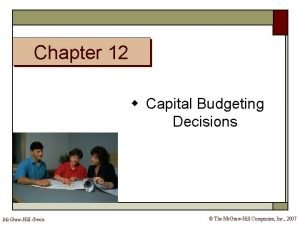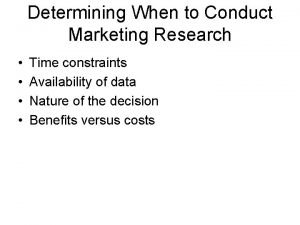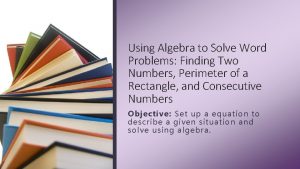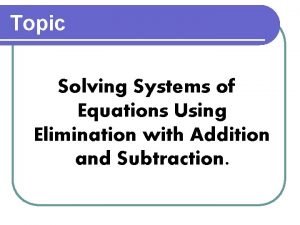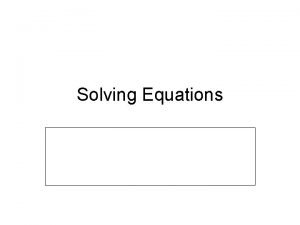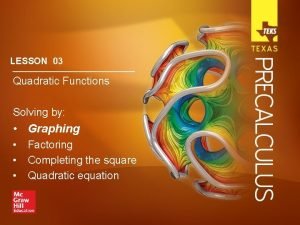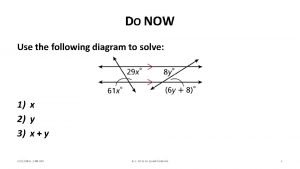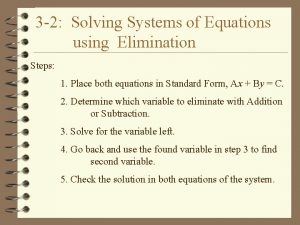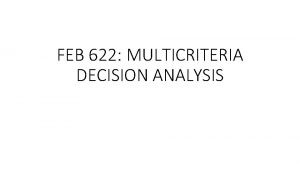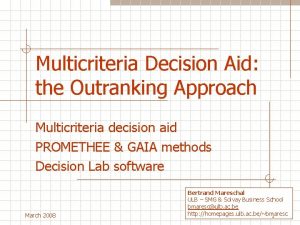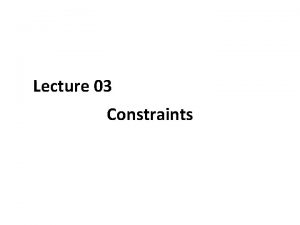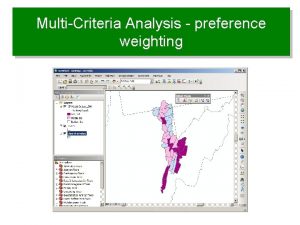USING PREFERENCE CONSTRAINTS TO SOLVE MULTICRITERIA DECISION MAKING
















- Slides: 16

USING PREFERENCE CONSTRAINTS TO SOLVE MULTI-CRITERIA DECISION MAKING PROBLEMS Tanja Magoč, Martine Ceberio, and François Modave Computer Science Department, The University of Texas at El Paso

Outline Multi-criteria decision making (MCDM) Traditional techniques to solve MCDM problem A novel approach Representing preferences over criteria in terms of constraints Narrowing down the search space

Multi-criteria decision making § § Comparison of multidimensional alternatives to select the optimal one § Pick the “best” car to buy § a set of alternatives Elements of a MCDM setting: § § cars (finitely many) § color, safety rating, price § color={red, black, grey}, safety rating={1, 2, 3, 4, 5}, price=[11000, 53000] a set of criteria a set of values of the criterion a preference relation for each criterion: § § red>black>grey, lower price is more preferred than higher price, higher safety rating is more preferred than lower safety rating Challenge: Combine partial preferences into a global preference

Traditional techniques to solve MCDM problems Utility based approaches: Maximax strategy Maximin strategy Weighted sum approach Non-additive approaches The Choquet integral w. r. t. a non-additive measure

Narrow down the search space from all possible values that criteria can take to a smaller space that contains the best alternative based on the preferences of an individual. Assumption: the decision maker is able to express his/her preference of a criterion over another criterion by means of how much of a criterion he/she would sacrifice in order to obtain higher value of the other criterion. � E. g. the individual knows how much more he/she is willing to pay for an increase in one star of safety rating. � Different tradeoff at different value.

Process of narrowing down the search space Map the domain of each criterion into an interval � Convert each of the intervals into the interval [0, 1] higher preference is given to values closer to 1 Original search space=cross product of these intervals Constraints on the search space: preferences provided by decision maker � Input how much the individual is willing to “pay” using one criterion to increase the value of other criterion by 0. 2 Use standard techniques for solving problems with constraints to narrow the search space

Example: Map domains into intervals Map domains of criteria into intervals: � Color={red, black, gray} [1, 3] with gray<black<red � Safety rating={1, 2, 3, 4, 5} [1, 5] � Price=[11000, 53000] Convert all interval domains onto a common scale [0, 1], where higher number means a higher preference: � Color: u(c)=(c-1)/2 � Safety rating: u(s)=(s-1)/5 � Price: u(p)=(53000 -p)/42000

Example: Importance of an increase The decision maker gives an importance value from 0 -10 for each increase in 0. 2 value in a criterion relative to another criterion 0 means the individual is not willing to sacrifice other particular criterion at all for increase in the value of the criteria 10 means the individual is willing to sacrifice lot for increase in the value of the criteria

Example: Importance of an increase Safety rating relative to price: � 0. 0 0. 2: 10 � 0. 2 0. 4: 9 � 0. 4 0. 6: 7 � 0. 6 0. 8: 5 � 0. 8 1. 0: 2 Sum of values = 33 Increase in safety rating from 0. 0 to 0. 2 is worth decreasing value of price by (10/33)*100% Increase in safety rating from 0. 8 to 1. 0 is worth decreasing value of price by (2/33)*100%

Example: Constraint based on safety rating and price Price 1. 0 0. 8 0. 6 0. 4 0. 2 0. 4 0. 6 0. 8 1. 0 Safety rating

Example: Constraint between safety rating and price Price 1. 0 0. 8 0. 6 0. 4 0. 2 0. 4 0. 6 0. 8 1. 0 Safety rating

Example: Constraint between safety rating and price Price 1. 0 0. 8 0. 6 0. 4 0. 2 0. 4 0. 6 0. 8 1. 0 Safety rating

Example: All constraints together Constraints: safety rating – price – color safety rating – color Each constraint itself narrows down the search space Use standard techniques used to narrow down the search space even more

Example: Constraint between safety rating and price Price 1. 0 0. 8 0. 6 0. 4 0. 2 0. 4 0. 6 0. 8 1. 0 Safety rating

Conclusion What have we done? Why is this approach better? Represent multi-criteria decision making problem in terms of preference constraints defined by the decision maker Reduce the initial search space by using standard continuous constraint solving techniques Speeds up the process of finding the best solution by fast elimination of domains that certainly do not contain the best solution What is the next step? Define more complex/general preferences Combine importance and interactions (Choquet) with preferences

Thank you QUESTIONS? ? ?
 No decision snap decision responsible decision
No decision snap decision responsible decision Dividend decision in financial management
Dividend decision in financial management A preference decision in capital budgeting
A preference decision in capital budgeting A preference decision in capital budgeting:
A preference decision in capital budgeting: Mamdm
Mamdm Using recursion in models and decision making sheet 3
Using recursion in models and decision making sheet 3 Decision making using excel
Decision making using excel In a marketing decision constraints are
In a marketing decision constraints are Decision table and decision tree examples
Decision table and decision tree examples Using subqueries to solve queries
Using subqueries to solve queries Using big data to solve economic and social problems
Using big data to solve economic and social problems Using algebra to solve word problems
Using algebra to solve word problems Solve a system of equations using elimination
Solve a system of equations using elimination Used to solve equations opposite
Used to solve equations opposite Solve using the quadratic formula x^2-2x-62=0
Solve using the quadratic formula x^2-2x-62=0 Using the following diagram, solve for x.
Using the following diagram, solve for x. Solve a system of equations using elimination
Solve a system of equations using elimination



